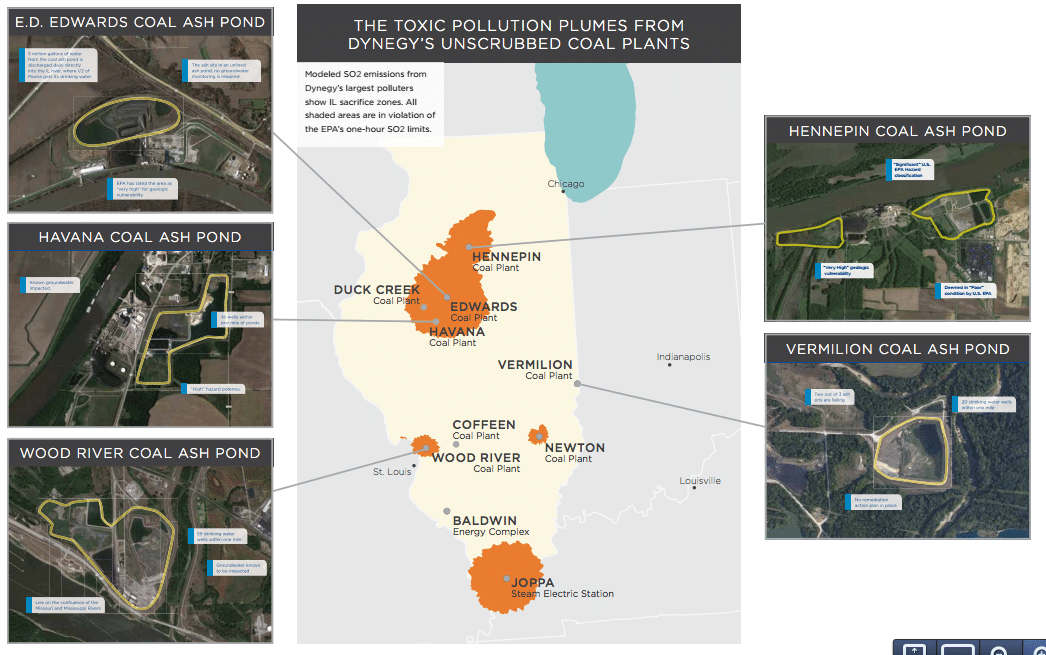Central Illinois Healthy Community Alliance, Sierra Club, Prairie Rivers Network Highlight Path for Communities to Transition Away from Risky Coal
PEORIA – Today, the Central Illinois Healthy Community Alliance (CIHCA), Prairie Rivers Network and the Sierra Club released a report highlighting the risk posed by Dynegy’s coal-fired power plants on communities across Illinois.
The report is the first comprehensive collection of Dynegy’s environmental and public health impacts state-wide. The report chronicles Dynegy’s history of risky behavior, the health costs associated with pollution from Dynegy’s aging coal plants, cleanup risks and costs that towns could face if a coal ash disaster occurs at a Dynegy coal ash pit, and Dynegy’s troubled history with labor and town relations. The report goes on to outline the importance of building responsible transition plans for Illinois communities that have been saddled with decades of coal pollution and are ready to build local clean energy economies.
“This report clearly demonstrates that Dynegy has shifted the burden of its heavily polluting business to the communities surrounding its plants, placing the health costs of pollution, and the potentially devastating costs of coal ash disaster squarely on those living nearby.” said Kady McFadden, Organizing Representative with the Sierra Club Beyond Coal campaign in Illinois. “Illinois has no time to waste demanding a transition away from coal, and requiring a smart transition plan in communities that have been calling for clean energy and cleaner air for years.”
The report implicates Dynegy in devastating past, present, and future pollution impacts. The company is responsible for the continuing coal ash damage at the Vermilion plant along the Vermilion River. The company’s ED Edwards plant is implicated in causing federally designated unsafe air quality in Peoria, and several additional plants across the state threaten local air quality. Many plants also dump coal ash directly into the Illinois River, putting arsenic, mercury, and lead directly into one of Illinois’ most important drinking water and recreational sources. The report contains maps demonstrating the extent of Dyengy’s air and water pollution state-wide.
“I want to make my community a safe place for my children to grow up and thrive, and dangerous pollution from Dynegy’s coal plant takes that power away from me as a parent,” said Robin Garlish, a mother from Pekin who lives near Dynegy’s E.D. Edwards coal plant and member of the CIHCA. “This report portrays the terrifying percentage of our state that is blanketed by pollution from Dynegy’s coal plants. It is time to build a plan to move away from dangerous coal pollution in Illinois, and we’re going to push Dynegy to build that plan with all community stakeholders present.”
The report also reveals the long-known and pervasive coal ash problems at Dynegy’s coal plants. The Illinois River is hit hard by Dynegy’s Duck Creek, E.D. Edwards, Havana, and Hennepin plants, which all discharge polluted water to the river at a rate of more than 1,043 million gallons daily. Dynegy’s history with coal ash contamination at its retired Vermillion coal plant in central Illinois raises a red flag for other communities where Dynegy is dumping coal ash into aging coal ash pits.
“So many of Dynegy’s coal ash pits are already leaking and are disaster areas waiting to happen,” said Carrie Otto, Organizer with Prairie Rivers Network. “Protecting clean water is vital, and transitioning away from coal is the simplest way we can avoid producing the dangerous waste that Dynegy dumps near our rivers.”
Beyond highlighting risks, the report outlines a three step checklist for local decision makers to protect their communities from Dynegy’s dangerous track record: advocate for public health and a healthy environment, support clean energy, and protect the community workforce.
View Full Report Here
###








